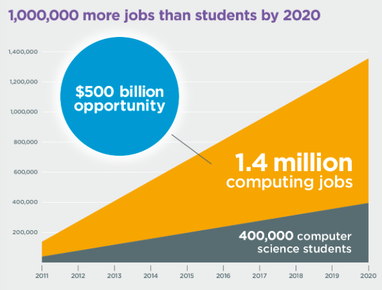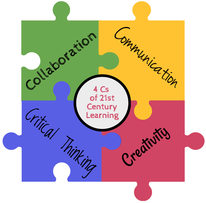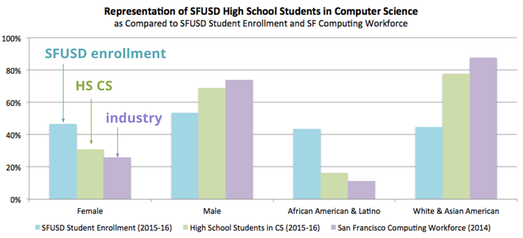Why Teach CS? Link to this section
"No other subject will open as many doors in the 21st Century, regardless of a student’s ultimate field of study or occupation, as computer science."
-The Computer Science Teachers Association (CSTA) in Running the Empty: Failure to Teach K-12 Computer Science in the Digital Age, 2010
Alignment to Vision 2025 Link to this section

In guiding SFUSD’s transformation, Vision 2025 recognizes that all of our students must be proficient in STEM, which must include computer science (CS). The graduate profile states that all San Francisco public school graduates must learn how to “navigate and engage in a 21st century global society,” and explicitly calls out computer science as one critical element. In our new digital age, students must be able to do more than simply use a computer; they must understand how computers and algorithms work, explore potential applications and impact, and develop the skills required to creatively use this knowledge to solve real-world problems.
Tremendous Career Opportunities Link to this section

Science, technology, engineering, and mathematics (STEM) jobs currently comprise the fastest growing job sector, and two-thirds of these jobs involve computing (Bureau of Labor Statistics, 2013). The Association for Computing Machinery (ACM) projects the creation of an additional 150,000 computing jobs annually through 2020. If the trend continues in which fewer than 40,000 American students receive bachelor’s degrees in computer science each year, about 70% of these 1.4 million new computing jobs will go unfilled by 2020, creating a large opportunity gap (Wingfield, 2012; Code.org, 2013). About 10% of this growth will be in the state of California, where computing job opportunities are growing at 4.1 times the state average (Page, 2015).
Relevant to All Industries Link to this section

Regardless of a student’s ultimate occupation, CS will be critical to developing a clear understanding of the principles and practices of the technologies that underlie our computing-intensive world. Since our students will live in a world that is even more heavily influenced by computing, we must introduce them to structured problem solving and computational thinking prior to entering college or the workforce. In the 21st century, everyone must have a basic understanding of the underlying algorithms of computer-based conveniences, from electronic voting to online shopping.
Important Transferrable Skills Link to this section

Computer science teaches transferable skills that are critical for all students; these include creative problem solving and innovative thinking. CS requires students to work cooperatively, consider the context of the situation, and balance the robustness, user-friendliness, maintainability, and correctness of computer solutions to real-world issues. CS supports and links to other sciences. It is not simply one more discipline to learn; rather, it is a methodology that enables the study of and innovation in other disciplines.
A Critical Issue of Equity Link to this section

Currently, women, African Americans, and Latinos are vastly underrepresented in the computer science workforce. In 2013, African Americans and Latinos comprised only 14% of all computer programmers, while women comprised only 23% (Bureau of Labor Statistics, 2013). The racial disparity is even greater at some tech giants like Google, Twitter, Facebook, Yahoo!, and LinkedIn, where only 5-6% of the workers are underrepresented people of color (Weise & Guynn, 2014). Unfortunately, the students currently accessing SFUSD’s high school CS courses mirror the computing workforce (TechSF & Office of Economic Workforce Development, 2014; College Board, 2014).
For more information, watch the videos below and read a short article from the Association for Computing Machinery (ACM),
Link to this section
This page was last updated on November 2, 2022

